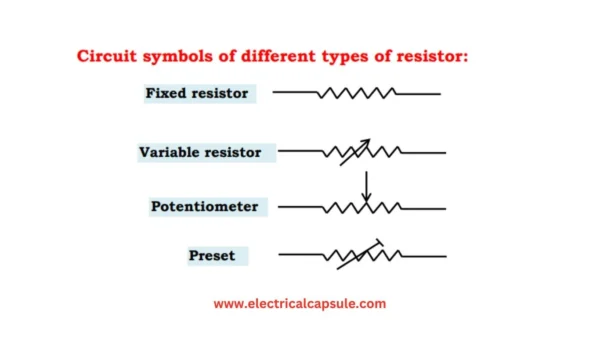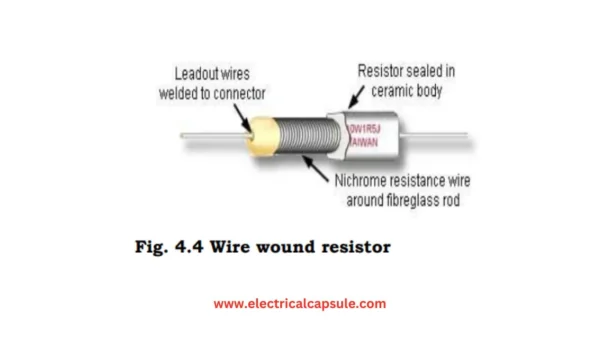Resistor is a component which is used to limit the flow of current. The passive component which offers a specified value of resistance in the circuit is known as a resistor.
Resist means to oppose. All the materials offer a little or more opposition to the flow of electric current through them. The property of the material to oppose the flow of current is known as resistance. The resistance of the material is not affected by the direction of flow of current i.e. its effect is same for both AC and DC. The resistance of the material is denoted by R and its SI unit is ohm (Ω). Types of Resistor and their applications given below.
Applications of resistor-
Resistors are used to
- Limit the current in a circuit.
- Divide the voltage.
- Protect the circuit elements.
- Dissipate energy.
Specification of Resistors-
Some important specification of resistors are ohms rating, power rating and
tolerance.
1-Ohms rating:-
It specifies the value of the maximum resistance offered by the resistor when it is used in the circuit.
2-Power rating:-
The maximum power a resistor can dissipate safely is called power rating. It is expressed in watts. Since P = I
2R, therefore the power dissipation of a resistor depends on the current flowing through it.
3-Tolerance value:-
The percentage variation in the resistance value with respect to its marked value is called tolerance. Resistors have tolerance value of about ±1 % to ±20 %.
4-Temperature coefficient:-
The resistance of the material also depends on its temperature. Hence temperature coefficient specifies how resistance varies with temperature. In all the conducting materials, resistance increases with
increases in temperature but in semiconductor materials, the resistance decreases with an increase in temperature. Temperature coefficient of resistance expressed as.
Types of Resistors-
Resistors are broadly classified into two types, they are
- Fixed resistor
- Variable resistor

A fixed resistor is one whose resistance value remains constant; however there may be some variation in their value due to temperature variation. They are further classified depending upon the type of material used for construction. They are
- Wire Wound Resistors
- Carbon Composition Resistors
- Cermet Oxide Resistors
- Metal Oxide Resistors
- Thin Film Resistors
- Thick Film Resistors
- Fusible Resistors
- Carbon Film Resistors
- Metal Film Resistors
A variable resistor is one whose resistance value can be varied over a specified range. They are further classified based on the materials used and type of construction. They are
- Potentiometer
- Preset
- Rheostat, etc.
Types of Resistor and their applications–
1-Wire Wound Resistor-
Wire wound resistor is made by winding a wire of known length on an insulated base. Generally, porcelain base is used as supporting material and eureka wire (an alloy of 60% nickel and 40% copper) as resistance wire. Two ends of the wire are connected to metal leads. These leads are taken out from the two ends for connection purposes. The entire structure is encapsulated and enamel paint is coated to protect it from atmospheric contamination and to prevent from external electric shock.
Finally, their specifications are marked on its body. A wire wound resistor is shown in fig. 4.4. Wire wound resistors are available in the range of 0.01 Ω to 100 kΩ with 5W to 50W power ratings.

These kinds of resistors have good stability, reliability and high power ratings. It is easy to construct a low value resistor of 0.01 Ω with lowest tolerance value up to 5%. On other hand, it is difficult to construct a high value resistor because their size is quite big which is unsuitable for small sized equipments. They are unsuitable for high frequency circuits because their effective resistance is increased due to presence of inductive reactance in them
Applications-
- These resistors are used in audio frequency applications.
- These are used in large current applications and also in ammeters.
Wire wound resistor MCQ-
Q1: What is the primary material used for the resistive wire in wire-wound resistors?
A) Copper
B) Nickel-chromium
C) Carbon
D) Aluminum
Answer: B) Nickel-chromium
Q2: Which characteristic is typically associated with wire-wound resistors?
A) High precision
B) Low power rating
C) High inductance
D) Low temperature coefficient
Answer: C) High inductance
Q3: What is the main advantage of wire-wound resistors?
A) High accuracy
B) Low cost
C) High power handling
D) Small size
Answer: C) High power handling
Q4: Which of the following is NOT a typical application for wire-wound resistors?
A) Power supplies
B) Audio equipment
C) High-frequency circuits
D) Heating elements
Answer: C) High-frequency circuits (due to high inductance)
Q5: How do wire-wound resistors typically respond to temperature changes?
A) Increase in resistance
B) Decrease in resistance
C) No change in resistance
D) Non-linear change in resistance
Answer: A) Increase in resistance
Q6: What is the typical tolerance range for wire-wound resistors?
A) ±1%
B) ±5%
C) ±10%
D) ±20%
Answer: B) ±5% (although it can vary depending on the specific resistor)
Q7: Which type of wire-wound resistor has a ceramic core?
A) Power resistor
B) Precision resistor
C) High-voltage resistor
D) Non-inductive resistor
Answer: A) Power resistor
8-What is the primary material used in wire-wound resistors?
- A) Carbon
- B) Metal wire
- C) Ceramic
- D) Plastic
Answer: B) Metal wire
9-Which of the following is a characteristic of wire-wound resistors?
- A) High power rating
- B) Low precision
- C) High noise
- D) Non-linear resistance
Answer: A) High power rating
10-Wire-wound resistors are often used in applications that require:
- A) High-frequency response
- B) Low power consumption
- C) High accuracy and stability
- D) Flexibility
Answer: C) High accuracy and stability
11-Which of the following is a disadvantage of wire-wound resistors?
- A) High temperature coefficient
- B) Large physical size
- C) High inductance at high frequencies
- D) All of the above
Answer: D) All of the above
12-Wire-wound resistors are commonly used in:
- A) Low-frequency circuits
- B) High-frequency circuits
- C) Power supply circuits
- D) Both A and C
Answer: D) Both A and C
13-The primary function of a wire-wound resistor in a circuit is to:
- A) Store energy
- B) Control voltage
- C) Limit current
- D) Convert AC to DC
Answer: C) Limit current
14-Which of the following factors does NOT affect the resistance of a wire-wound resistor?
- A) Length of the wire
- B) Material of the wire
- C) Color of the wire
- D) Cross-sectional area of the wire
Answer: C) Color of the wire